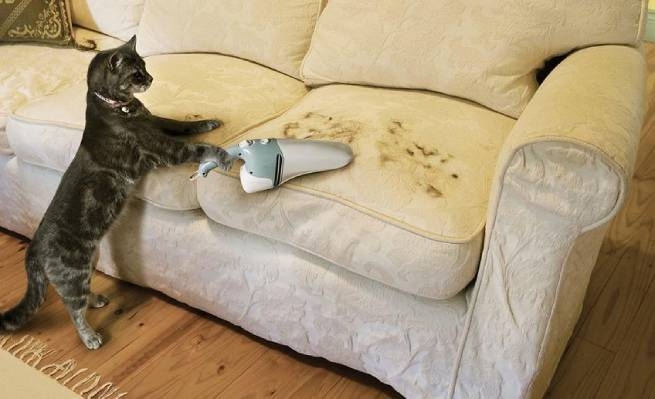Beloved pets give us not only endless love, but also a number of problems – hairballs on the floor and sofa, scattered food, dirty paw marks after a walk. Experts give practical advice on how to keep your home clean and avoid allergies.
Shedding and micropollutants
Dyson laboratory experts warn that shedding wool, for example, is anything but harmless. It grows in cycles: some hairs fall out and make room for new ones. The hair growth phase lasts differently, depending on the season. For example, German Shepherds and Collies shed more hair in spring and autumn, so during this period there is more of it, it clogs into carpets and “sticks” to hard floors.
But, in addition to wool, a lot of small particles settle on the surfaces in the house, which are not visible to the naked eye. These are dandruff (particles of the skin that dust mites love so much), particles of dried saliva, urine and feces that fall from animal hair and contain allergens. This microscopic “set of allergens” can be airborne along with house dust, clogged in soft coverings – carpets, mattresses and pillows.
Cleaning every other day
Having domestic “woolen” pets in the house, wet cleaning will have to be done every two days. Unless, of course, you want to see hairballs on the floor and inhale specific “aromas”. Use a damp carpet brush and be mindful of nooks and crannies in the room – your pet’s food stash might be there. To make your home safe for health, experts recommend following 8 simple rules:
1. The “source of the problem” needs more often comb outso that the wool does not fly around the house. In addition, it is better to do it in one place, and then use a mini electric brush with nylon bristles.
2. Top down cleaning. Given the “volatility” of dandruff and hairs, it is better to start cleaning with cleaning surfaces, armchairs and sofas, and finish with the floor. Everything that cannot be washed can be cleaned with an electric brush – it will do a great job of removing skin particles, dandruff, dust mites and wool.
3. Removable covers and bedding, pillowcases from pillows and beds, where your pet likes to relax, should wash at 60°C. And do not forget to check the drum of the washing machine for wool after washing such things.
four. Vacuuming all surfaces needed slowly – in this case, the air stream and the nozzle roller will have more time to extract and remove deeply clogged wool.
5. “Plaking” wool animals from surfaces. Some vacuum cleaner models are equipped with nylon and carbon fiber bristles. They “fluff up” the wool and “flake” it from the surface to which it is electrostatically adhered. If you use a vacuum cleaner attachment with a strip of “collecting” bristles, it will attract wool to itself. In some cases, a lint roller will do the trick, but it won’t remove the skin particles that cause allergies.
6. You need to vacuum often but little
Animal hair collects on carpets and forms clumps on hard floors. If you vacuum a little, but often, the wool will stop accumulating. It is very important to regularly vacuum upholstered furniture and the floor to prevent the accumulation of dust, skin particles and hairs.
7. Vacuum in different directions – an effective way to collect more wool and get it stuck in the depths. Studies show that it is enough to change direction two or three times.
eight. latex gloves – ideal assistants in cleaning upholstered furniture from wool. Try it! Run your gloved hands over car seats, chairs and armchairs in your room, and wool will instantly stick to them. After washing them in running water, you can continue the process.
A particularly careful approach is required when cleaning cat houses, beds, bird cages – they serve as a source of an unpleasant odor. To wash the cages, only hot water is used, without any means, and soft sheets are cleaned with a vacuum cleaner, steam cleaner and washed periodically.
Pet food bowls should be washed after every feeding, even if you only use dry food. Buy a good litter for your cat litter and wash the litter boxes regularly. Animal lovers who have pets often share life hacks:
- A soft rug at the entrance to the apartment will retain excess moisture after walking in the rain. Keep a paw towel by the door. If they are too dirty, it is better to wash the dog in the bathroom.
- Overalls made of waterproof fabric for a dog will not only protect from the cold in bad weather, but much less dirt will get into the house.
- Ticks, fleas and other parasites are not uncommon guests of pets. Inspect their coat regularly, use good pharmacy insect repellents so that they do not settle in the house.
Who says keeping a pet in the house and keeping the house clean is easy? But in this case, “love requires sacrifice.” The main feature of cleaning in a house with an animal is the constant washing of floors and wiping surfaces with a damp cloth, and, of course, competent care for your pets, states BB.LV.







More Stories
Association of Professional Nutritionists to be created in Greece
The first ever Miss Artificial Intelligence beauty contest has been announced.
100-year-old Greek woman undergoes heart surgery